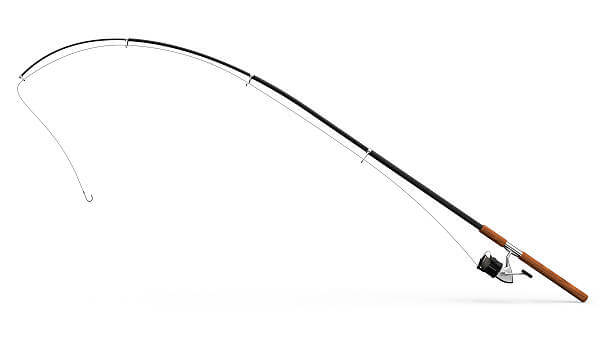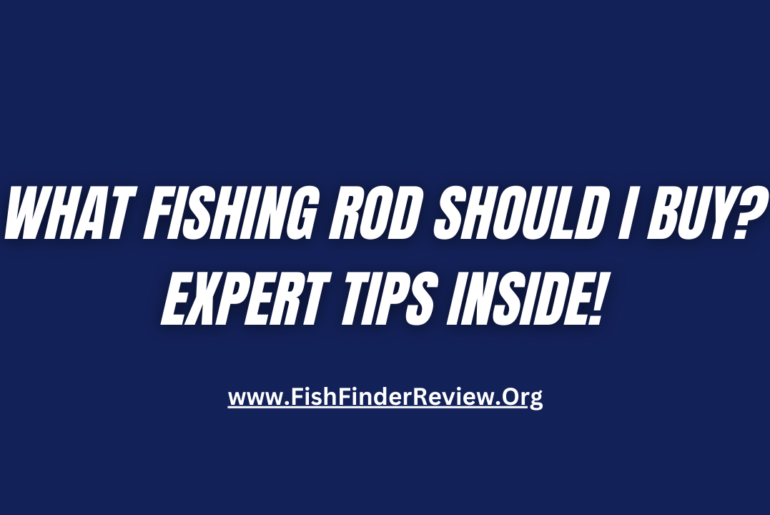If you’re wondering which fishing rod to buy, you’re in the right place! Choosing the perfect fishing rod can make all the difference in your angling adventures. From freshwater to saltwater, and various fishing styles in between, finding the right rod tailored to your needs is essential.
In this guide, we’ll break down the key factors to consider, helping you make an informed decision so you can reel in those unforgettable catches effortlessly. So, let’s dive in and explore the world of fishing rods together!
Types of Fishing Rods

Fishing rods are as diverse as the fish you aim to catch, each designed for specific purposes and fishing conditions. Choosing the right type of fishing rod is crucial for a successful angling experience. In this comprehensive guide, we’ll explore the various types of fishing rods, shedding light on their unique characteristics and ideal use cases.
1. Spinning Rods: Spinning rods are perhaps the most versatile and popular choice among anglers. They feature a reel mounted beneath the rod, allowing for easy casting with a spinning motion. Spinning rods are suitable for beginners and experts alike, ideal for catching a wide range of fish species, from panfish to larger gamefish. They’re known for their ease of use, making them a go-to choice for anglers of all skill levels.
2. Baitcasting Rods: Baitcasting rods are favored by experienced anglers seeking precision and control. They are paired with baitcasting reels, which sit atop the rod. These rods excel in casting accuracy and are ideal for heavy cover fishing and targeting larger species like bass and pike. However, they have a steeper learning curve, making them less beginner-friendly compared to spinning rods.
3. Fly Rods: Fly fishing enthusiasts swear by fly rods, designed specifically for casting lightweight flies. These long and flexible rods allow for delicate presentations and are commonly used in freshwater settings, particularly for trout and salmon. The type of fly rod you choose depends on the size of the fish you’re targeting and the specific fly-fishing technique you prefer.
4. Surfcasting Rods: Surfcasting rods are heavy-duty, elongated rods designed for fishing in the surf or from the shoreline. They provide the casting distance needed to reach fish beyond the breakers and are commonly used for saltwater species like striped bass, redfish, and sharks. These rods are built to handle the challenges of saltwater environments, with corrosion-resistant components.
5. Ice Fishing Rods: Ice fishing demands a unique type of rod due to the conditions. Ice fishing rods are usually short and stubby, designed for drilling through ice holes and catching fish in cold, icy waters. They often come with sensitive tips to detect subtle bites when the fish are less active in the frigid temperatures.
6. Telescopic Rods: Telescopic rods are highly portable and convenient for anglers on the move. These rods can be extended to full length when fishing and collapsed for easy transportation. They are popular among backpackers, travelers, and those who value mobility while still seeking a good fishing experience.
By understanding the different types of fishing rods and their unique characteristics, you can make an informed decision and enhance your chances of a successful and enjoyable fishing trip. Whether you’re a beginner or a seasoned angler, there’s a perfect fishing rod out there waiting for you to discover and master. Happy fishing!
Must Read:- Lucky Handheld Fish Finder Review! (Buyer’s Guide & Tips)
Factors to Consider When Buying a Fishing Rod?
Investing in the right fishing rod can significantly impact your angling success. With countless options available, it’s essential to consider various factors to ensure you choose the perfect rod for your fishing needs. In this guide, we’ll explore the key factors that should influence your decision when purchasing a fishing rod.
1. Fishing Type and Target Species: One of the primary considerations when buying a fishing rod is the type of fishing you intend to do and the species you want to target. Different rods are designed for various fishing techniques, such as freshwater, saltwater, fly fishing, and ice fishing. Each type has unique requirements. For example, if you’re into bass fishing, a baitcasting rod may be ideal, while fly fishing for trout requires a specialized fly rod.
2. Rod Length: The length of your fishing rod is critical, as it affects casting distance, accuracy, and leverage when reeling in fish. Longer rods generally cast farther, making them suitable for open water and surf fishing. Shorter rods are excellent for close-quarters fishing or when navigating through dense vegetation. Consider the specific fishing environment to determine the ideal rod length.
3. Power and Action: Rod power and action are vital characteristics that dictate the rod’s strength and flexibility. Power refers to the rod’s ability to handle heavy or light loads, while action describes how much the rod flexes and where it bends. For instance, a heavy-power, fast-action rod is suitable for big game fishing, whereas a light-power, moderate-action rod is ideal for finesse techniques like drop-shotting.
4. Material and Construction: Fishing rods are made from various materials, including fiberglass, graphite, and a combination of both (composite). Graphite rods are lightweight and sensitive, making them popular among anglers. Fiberglass rods, on the other hand, are more durable and offer flexibility. The choice between materials depends on your fishing style and preferences.
5. Handle and Grip: The handle or grip of a fishing rod plays a crucial role in comfort and control. Common handle materials include cork and EVA foam. Cork handles offer a traditional and comfortable grip, while EVA foam handles are easy to clean and maintain. Choose a handle that feels comfortable in your hand, especially if you plan to spend extended periods on the water.
6. Reel Seat and Compatibility: Ensure that the fishing rod has a reel seat that is compatible with your chosen reel. Reel seats come in various designs and sizes, so it’s important to check compatibility before making a purchase. A secure and well-matched reel seat ensures that your reel stays firmly in place while fishing.
7. Budget: Budget is always a factor when buying any fishing gear. Fishing rods come in a wide price range, and while quality often correlates with price, there are excellent options available for various budgets. Determine how much you’re willing to spend and seek a rod that offers the best value within your price range.
8. Brand and Warranty: Reputable brands often provide quality assurance and warranties for their fishing rods. Consider choosing a rod from a trusted manufacturer known for durability and customer support. A warranty can be particularly valuable in case of unexpected damage or defects.
9. Try Before You Buy: Whenever possible, try out the rod before purchasing it. Visit a local tackle shop and test how it feels in your hands, practice a few casts if allowed, and get a sense of its overall comfort and usability.
The Best Fishing Rods on the Market
Fishing is a popular pastime for people of all ages and skill levels. Whether you’re a seasoned pro or just starting out, having the right fishing rod can make all the difference. But with so many different rods on the market, it can be tough to know which one is right for you.
That’s why we’ve put together this list of the best fishing rods on the market. These rods are all highly rated by anglers and have been proven to be effective in a variety of fishing conditions.
1. Shimano Stradic CI4+
The Shimano Stradic CI4+ is a spinning rod that’s known for its lightness, durability, and casting performance. It’s made with high-quality materials, including carbon fiber and titanium, which makes it incredibly strong and lightweight. The Stradic CI4+ also features a number of innovative features, such as Shimano’s X-Protect water resistance system and Hagane Gear durability system.
2. Daiwa Tatula LT
The Daiwa Tatula LT is another great spinning rod that’s known for its lightness and durability. It’s made with a carbon fiber blank and features a number of innovative features, such as Daiwa’s Air Rotor technology and T-Wing System. The Tatula LT is a great choice for anglers who are looking for a high-quality, lightweight spinning rod.
3. Abu Garcia Revo SX
The Abu Garcia Revo SX is a baitcasting reel that’s known for its versatility and durability. It’s made with a carbon fiber blank and features a number of innovative features, such as Abu Garcia’s MagTrax braking system and PowerStack Carbon Drag system. The Revo SX is a great choice for anglers who are looking for a versatile and durable baitcasting reel.
4. St. Croix Legend Elite
The St. Croix Legend Elite is a spinning rod that’s known for its sensitivity and casting performance. It’s made with a premium carbon fiber blank and features a number of innovative features, such as St. Croix’s Integrated Poly Curve (IPC) technology and Integrated Reel Seat (IRS) technology. The Legend Elite is a great choice for anglers who are looking for a high-quality, high-performance spinning rod.
5. G. Loomis NRX+
The G. Loomis NRX+ is a baitcasting reel that’s known for its sensitivity and casting performance. It’s made with a premium carbon fiber blank and features a number of innovative features, such as G. Loomis’s Multi-Taper Design (MTD) technology and FCR (Finite Carbon Reduction) technology. The NRX+ is a great choice for anglers who are looking for a high-quality, high-performance baitcasting reel.
6. Other Great Fishing Rods
In addition to the rods listed above, there are a number of other great fishing rods on the market. Here are a few more options to consider:
- Shimano Curado K (Baitcasting)
- Daiwa Tatula CT (Baitcasting)
- Abu Garcia Revo SX (Spinning)
- St. Croix Mojo Bass (Spinning)
- G. Loomis E6X (Spinning)
Choosing the Right Fishing Rod
When choosing a fishing rod, there are a few factors to consider:
- Type of fishing: Are you going to be fishing for bass, trout, salmon, or something else? Different types of fishing require different types of rods.
- Action: The action of a rod refers to how it bends when you cast. A fast-action rod bends in the upper third of the blank, while a slow-action rod bends in the lower third of the blank. Fast-action rods are ideal for casting long distances, while slow-action rods are ideal for fishing in close quarters.
- Power: The power of a rod refers to how much backbone it has. A heavy-power rod is ideal for fishing with large lures and heavy line, while a light-power rod is ideal for fishing with small lures and light line.
- Length: The length of a rod is important to consider depending on where you’re going to be fishing. If you’re going to be fishing from a boat, you’ll want a longer rod. If you’re going to be fishing from shore, you’ll want a shorter rod.
FAQs About Fishing Rods
Ans – Fishing rods come in various types, including spinning, baitcasting, fly, surfcasting, ice fishing, and telescopic rods. Each type is designed for specific fishing techniques and environments.
Ans – Selecting the right fishing rod depends on factors like your fishing style, target species, and fishing environment. Consider the rod’s length, power, action, material, and handle type to make an informed choice.
Ans – Rod power indicates its strength, ranging from ultralight to heavy. Action refers to how and where the rod flexes when pressure is applied. These factors determine the rod’s suitability for different fishing scenarios.
Ans – Fiberglass rods are durable and flexible, making them suitable for heavy-duty applications. Graphite rods are lightweight and sensitive, ideal for finesse fishing. The choice depends on your preferences and fishing style.
Ans – Regular maintenance involves cleaning your rod, checking for damage, and storing it properly. Rinse your rod with freshwater after saltwater use, avoid high-impact situations, and store it in a rod holder or protective case when not in use.
Ans – Expensive rods often offer better materials and craftsmanship, resulting in improved performance and durability. However, there are quality options available at various price points, so it’s essential to balance your budget and needs.
Must Read:-
Last Words
In conclusion, selecting the right fishing rod is a crucial step to enhance your angling experience. Consider your fishing type, target species, rod length, power, and action, as well as the materials, handle, reel seat compatibility, budget, brand, and warranty. By carefully evaluating these factors, you can confidently choose a fishing rod that suits your needs, ensuring a more enjoyable and successful time on the water. Happy fishing!





